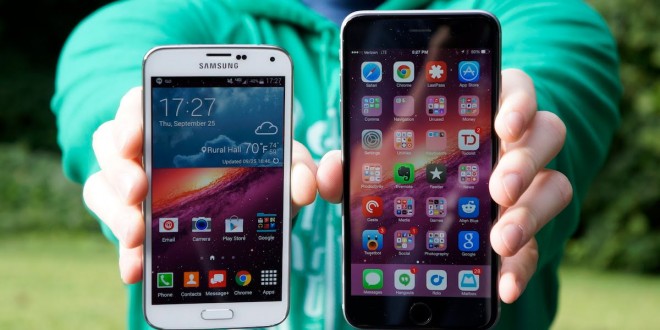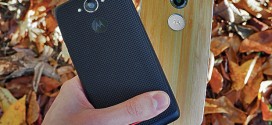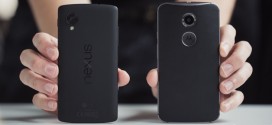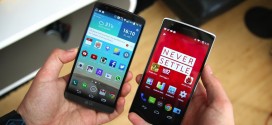The Galaxy S5 was one of the most criticized, yet one of the best selling devices of 2014. The handset was launched early in the year, as usual, and while the design of the device was atrocious as some might say, the functionality and features that were build into the band-aid were quite impressive. The Galaxy S5 design was and is criticized because of its plastic chassis and faux chrome finish on the edges, which doesn’t look nor feel any good. The dimpled perforated back panel on the device is described as horrid by most users and those who hate the design but love the device opt for cases, covers and skins.
The Galaxy S5 is not all bad, though, and its design has actually brought on something positive in the smartphone market and for Samsung: the realization that fans would rather have a nice design than a cheap one. While that philosophy is and has been cosher for a while now, the Galaxy S5 prompted Samsung to realize that it was time for them to abandon their good old design elements and try to make something that would not only impress with specs and features, but with design too. Consequently, the company came out with the Galaxy Alpha just in time to meet the launch of the iPhone 6 and the behemoth iPhone 6 Plus.
The Galaxy Alpha is a whole lot different in design from the Galaxy S5, Samsung choosing to encase its frame in metal, giving the handset that much-adored premium feel many were asking for. Samsung didn’t stop at the Alpha, though, the company designing three more phones in the likes of the premium mid-ranger, the Galaxy A3, A5 and A7 and is now en-route to launching yet another two metal smartphones, the Galaxy E5 and E7. Even though the South Korean smartphone giant said that it would cut back on smartphone models, we haven’t seen any cutbacks, rather just new leaks and announcements about even more new models coming our way next year.
The Galaxy S5 doesn’t really compare in design with the iPhone 6 Plus or its smaller brother, the iPhone 6, because Apple greeted us with yet another metal design, as we’ve been used to for year now. The iPhone 6 Plus launch event brought us something entirely new from the Cupertino company. No, I’m not talking about the Apple Watch, since that’s not even released yet, rather I’m talking about the double launch Tim Cook decided to go with.
The Apple-hype this year was massive, building up around the two new phones and the watch, and Tim Cook’s open letter about his sexuality only boosted interest towards the company. The iPhone 6 Plus and its sibling managed to sale in record numbers in the first weekend after they were launched, topping the 10 million units number. Can you imagine ten million people buying either the iPhone 6 Plus or the 6 in a time-span of three days? That’s certainly a record and Apple was proud to announce, shortly after, the introduction and launch of the handset in China, to boost numbers even more. Moreover, Tim cook and co. also launched Apple Pay in the United States, a new mobile payment platform that aimed to revolutionize the way we interact with cashiers.
Even though Apple Pay wasn’t quite as successful as the company hoped, major retailers backing out abruptly in favor of a different platform, the service still managed to rake up quite a big fan-base so to speak, so we are expecting to see it launch in Europe and in the U.K. early next year. A job position has been leaked for a London-based intern that would handle the Apple Pay business in the region, so we’re fairly sure the launch is near.
Even though the Galaxy S5 launch event didn’t come with so much hype surrounding it, that didn’t stop the handset from becoming one of this year’s best selling smartphone. Samsung did experience an abrupt fall in Galaxy smartphone sales this year, hence the announcement of a cutback in future models, yet there are millions of Galaxy S5 owners out there who are pretty content with their flagship. As usual, the company released a few variants of the Galaxy S5, such as the Galaxy S5 Mini, Galaxy S5 Active and Galaxy S5 Sport. The rugged variants of the phone weren’t as big as we were expecting them to be, but they did show off how Samsung is trying to listen to customers and satisfy their needs.
With a fairly successful product and a crazy-hyped product launch, the Galaxy S5 and iPhone 6 Plus are among the biggest and best received handsets of the year, aside from a few nooks and crannies you would find with any flagship these days. This year was indeed packed with new and innovative launches like the LG G3, HTC One M8 and flagship killer OnePlus One, but none managed to rake up so many users in such a short time like the iPhone 6 Plus.
The iPhone 6 Plus was met with reticence at first, both from critics and users, because it was the first “phablet” Apple has ever launched and some were looking at it with skepticism. It is true that the flagship won’t fit in a normal pocket, but you’d get that feeling with the Nexus 6 and Galaxy Note 4, too, so it’s not surprising that Apple would cater to the current phablet-trend. In spite of many saying the iPhone 6 Plus is frail, weak and too big, the phone sold millions of units, demonstrating that even skeptics were curious as to how an Apple phablet came to be.
Besides all the announcements made alongside the iPhone 6 Plus launch, the phone itself came with a few entirely new things like fresh iOS 8 and optical image stabilization for the camera. The Galaxy S5 also incorporated a few new en-vogue additions like the fingerprint sensor and the heart rate monitor on its back. Apple fans will certainly appreciate the new features found in the flagship, while Android fans will curse at TouchWiz and the inconsistent fingerprint sensor on the Galaxy S5. That proves that even though Samsung tried innovating, it might have overdone it a bit. While a fingerprint sensor and heart rate monitor might seem like useful additions, users complaining about their functionality and uselessness is not good PR. Many have said that they would have preferred a better build or a bigger battery instead of these new en-vogue features only 1%ers use regularly.
Anyhow, hype and fame aside, let’s see what these two flagships are actually capable of. What’s more important, we’ll try to determine which has the better bang for buck ratio. If you aren’t familiar with my bang for buck obsession, let me explain: a good bang for buck, for me, means that a phone is worth the money and packs the same or stronger punch than a similarly priced device. In consequence. let’s see whether the Galaxy S5 packs the same punch as the iPhone 6 Plus for a lower price.
Since we already have the design part out of the way, making it (hopefully) clear that the iPhone 6 Plus aluminium unibody is superior to the Galaxy S5 plastic faux chrome band-aid body, let’s talk about displays. Display is the first thing one analyzes when checking out a new smartphone, since a better, crisper, sharper display is mostly the best choice. The Galaxy S5 display is a Super AMOLED 5.1 inch screen with a 1080*1920 resolution that adds up to a hefty 432 ppi pixel density. The iPhone 6 Plus display on the other hand is a bigger, LED-backlit IPS LCD with the same resolution, but a lower 401 ppi pixel density count.
Now, as you can probably deduce, the quality of the images shown on either displays are pretty high up there on the latter, definitely not QHD-level, but still pretty good. Since the human eye can barely discern any difference in ppi count when it’s above 350, it’s safe to say that both these displays are sharp and bright and have great viewing angles and outdoor visibility. I hope you’re sensing that “but” coming already… but the LED-backlit display of the iPhone 6 Plus offers a better user experience, allowing a more immersive experience with the touchscreen. At the same time, you’ve got a 0.4 inch bigger display on the Apple flagship, which can be a plus or a minus, depending on your preferences. If you like big screens, phablets and tend to abuse your phone’s various functions, the bigger iPhone 6 Plus might be more attractive to you. On the other hand, if you enjoy a moderate smartphone display, with great color reproduction and a lot of space, not having to use your phones for intricate apps that take up all your screen and are very filled with small details, the Galaxy S5 should be enough for your needs.
What I didn’t mention earlier when talking about functions and features, is the fact that Samsung decided to make the Galaxy S5 waterproof. No, not water resistant like the HTC One M8, rather IP67 certified, which means you won’t have to worry about it dropping to the bottom of the toilet and dying. It will be just fine. The dust- and waterproof certification on the device are certainly worth your while, especially if you’ve an active lifestyle that involves a lot of traveling. The iPhone 6 Plus, on the other hand, doesn’t shine in the durability department. We had to find something wrong with it seen, otherwise you might have accused me of advertisement. Well, I’m sure you’ve heard about the iPhone 6 Plus bendgate. The fact that a phone bends under a lot of pressure is nothing new, but it still proves that the uberly thin body of the 6 Plus is just not made for abusers. While it won’t bend in your pocket, it’s certainly more fragile than the run-of-the-mill Android smartphone.
Since we’re at durability, let’s talk about size. The Galaxy S5 measures 142 x 72.5 x 8.1 mm, while the iPhone 6 Plus measures 158.1 x 77.8 x 7.1 mm. As you can see, the iPhone 6 Plus is wider and taller than the Galaxy S5, but it is also a mm thinner than its competitor. Recently, we’ve seen the thin phone fad gaining speed, especially since word got out about the Gionee Elife S5.5, S5.1 and the Oppo R5, which is currently the thinnest smartphone ever. Naturally, with thin phones, the issue of bending becomes more obvious, since their bodies will react more easily to pressure. Alas, I must say, I would rather have a thicker phone than a paper-thin one, because I will constantly think that I had lost my phone since I won’t be feeling it in my pocket. Although that remark is a bit redundant in the case of the iPhone 6 Plus (seeing as it won’t fit in any of my pockets), I think you get what I’m saying.
Let’s get OS out of the way, shall we? Lovers of Android will be glad to hear that the Galaxy S5 Android 5.0 Lollipop update is rolling out and most editions of the device should already have the Lollipop treatment. Remember, the rollout is in stages, which means that not all devices get the Android 5.0 Lollipop OTA at the same time. In case you haven’t received the OTA yet, you can flash it yourself, although you’re going to have to use some of your experience (which I suppose you have if you are considering flashing the Galaxy S5) with flashing Android firmwares. Android 5.0.1 is also in the making, so we might see that update rolling out soon, too.
The iPhone 6 Plus was launched with Apple’s brand new iOS 8, which brings a whole lot of new features that make the phone a bit similar to Android ones. You can now put widgets in your notifications panel and you can actually use third party keyboards on your device. While iOS 8 does bring new functions, the most interesting part of it is Continuity, which proposes something in-between Samsung’s Flow and Pushbullet. With Continuity, you can pick up where you left off on iOS 8 from any device that is running the new OS. With Mac OS X integration, you can actually use the Handoff functions to do the same on your computer as well. Neat.
As far as OS goes with the Galaxy S5, you’re going to get TouchWiz, no matter what you do (except rooting your device and getting a nice stock factory image from Google, but that might void your warranty). TouchWiz isn’t the favorite of most Android users, but you can get by with it pretty nicely. TouchWiz on Android 5.0 Lollipop hasn’t changed much, save for the font which we’re glad to see disappearing. Still, the UI is pretty sluggish and you’re going to get annoyed when multitasking, but hey, Material Design elements have been nicely integrated, which is pretty good. We do expect improvements from Samsung on TouchWiz. I would mark TouchWiz as a minus, but that choice is based on user preference. The same goes for iOS 8, since Apple fans will be definitely delighted with the new features. Android users might find it hard to get used to the limitations of Apple’s OS.
Moving on to specs, the Galaxy S5 has a Snapdragon 801 CPU coupled with the Adreno 330 GPU, backed by 2 GB RAM and either 16 or 32 GB internal storage, expandable via microSD card. The iPhone 6 Plus has Apple’s new Apple A8 chipset on board with PowerVR GX6450 GPU, backed by a measly 1 GB RAM and either 16, 64 or 128 GB internal storage, no microSD card slot available. Since the iPhone 6 Plus has a 64 bit CPU, we wonder why the company decided to put so little RAM in the phone. It would have been better to see at least 2 or even 3 GB on board, but the iPhone 6 Plus still performs well. When it comes to overall performance, the Galaxy S5 tends to be a bit slower in comparison to Apple’s phablets, but the difference is negligible. Alas, you need to decide what kind of tasks you will use your future flagship for and decide based on that. The iPhone 6 Plus is definitely snappier than the Galaxy S5, but you do have to get used to iOS 8 and its major limitations. Your choice.
The camera setup has been greatly improved on the iPhone 6 Plus, Apple putting an 8 MP iSight sensor with optical image stabilization on the rear, featuring a dual-LED flash and a 1.2 MP FaceTime camera on the front. While 8 MP doesn’t sound like much, the phone still takes wonderful shots and records great quality video, with more manual customization integrated trough iOS 8 than ever. The Galaxy S5 on the other hand has a pretty beefy 16 MP camera with LED flash on the rear and a 2 MP front camera. That setup isn’t bad either, but it would have done better in the face of the iPhone 6 Plus if Samsung decided to put optical image stabilization in the package. Nonetheless, the Galaxy S5 camera handles itself pretty well, unless you move your hand too much when filming. Since I’m not a fan of smartphone photography and don’t usually use the camera on my phone, I would prefer not to pronounce a verdict here. Whether your prefer the Apple camera or the Galaxy S5 camera is entirely your choice. Still, you can be confident that both cameras will meet your needs.
Moving on to battery life, the Galaxy S5 packs a 2800 mAH battery which is good for up to a day and a half of mixed use and the iPhone 6 Plus battery, which measures 2915 mAH can hold that up as well. Although if you do use the cameras a lot on either device, your battery life will probably be cut in half (tops). Since battery life isn’t the strong point of any smartphone nowadays, we can safely say that you will be content with either device if you want good battery life. If you want the best there is in this chapter, you should check out the Galaxy Note 4 or the Sony Xperia Z4, which have a 2 day battery life.
Last, but not least, let’s see the prices for these flagship devices. Since we’re during a Holiday season right now, you’ll probably be able to get a good Galaxy S5 deal and an average iPhone 6 Plus deal, too. Since we’re used to Apple putting big prices on their devices, you won’t be amazed when you read that the 16 GB iPhone 6 Plus price is $750, the 64 GB model price is $850 and the 128 GB variant price is $950. The Galaxy S5 price isn’t much to look at either, the 16 GB model setting you back about $600, but you can find deals that go as low as $520. If you opt for a refurbished model, you can get it even cheaper, and that’s valid for the iPhone 6 Plus, too.
This comparison is indeed a bit hard, since you get great features with both the Galaxy S5 and the iPhone 6 Plus. Since I’m an Android user and fan, I would go for the Galaxy S5 and root it in the process, but when it comes to bang for buck, I’m inclined to say that you will get more for your money with the iPhone 6 Plus. Even though its price is a bit higher, the iPhone 6 Plus will definitely deliver a good user experience, as long as you don’t try to bend it a lot. The Galaxy S5 wouldn’t be a bad choice either, seeing as Samsung phones tend to hold out for a long time (not on the outside, though). The choice is up to you. Choose wisely and always consider your own needs when trying to choose your next smartphone. Good luck.
 Load the Game Video Games, Reviews, Game News, Game Reviews & Game Video Trailers
Load the Game Video Games, Reviews, Game News, Game Reviews & Game Video Trailers



